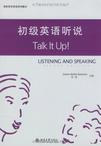初级英语听说
出版时间:2009-6 出版社:北京大学出版社 作者:Joann rishel Kozyrev 著 页数:160
前言
About the Program Talk It Up! is a complete text for the oral communication classroom. It provides activities to help students to build both the fluency and accuracy of their listening and speaking skills. These activities integrate listening and speaking practice and allow teachers the flexibility to choose the elements of the course that their students need most. The text is based on the model of oral communication skills shown in the following illustration. Listening, speaking, accuracy (pronunciation), and fluency work together to form the whole that is oral communication. In this model,the listening and speaking skills are represented by two overlapping circles. These skills are inherently related, although they sometimes operate separately.
内容概要
Talk It Up! Listening and Speaking is the first level of a complete three-level oral communication series designed for intermediate to advanced students. This text is designed for the lowintermediate student.Talk It Up! focuses on developing the students ability to communicate fluently and accurately by integrating listening and speaking practice through a variety of distinctive features.FEATURES AND BENEFITS,Book Design Chapter design has been streamlined to accommodate classroom use. Contextualized practice in listening and speaking helps students match skills and strategies to actual speech situations. Charts, illustrations, and diagrams of speech organs and speech sounds appeal to a variety of learning styles while helping students develop their pronunciation.Listening Exercises Listening exercises provide a wide taxonomy of skills and strategies students need. Listening passages feature natural-sounding speech, appropriate speech styles, and a variety of accents to promote listening skills development. Learning Styles and Strategies Talking Points and Class Projects encourage students to employ learned strategies. Relevant topics such as how to handle an emergency, understanding the credit system, and learning a language motivate students. Self-evaluation charts and speaking-activity evaluation forms help students set and track heir own progress.
书籍目录
Unit 1 FriendsPart Ⅰ Brainstorming,Part Ⅱ Thats What Friends Are ForPart Ⅲ Excuses, Excuses!Part Ⅳ CyberfriendsWeb ActivitiesTongue Twisters,Unit 2 Feeling at HomePart Ⅰ Brainstorming,Part Ⅱ A Good Apartment Is Hard to FindPart Ⅲ Getting Things FixedPart Ⅳ What a Neighborhood!Web ActivitiesTongue TwistersUnit 3 Making ConnectionsPart Ⅰ BrainstormingPart Ⅱ E-Mail ConnectionsPart Ⅲ Send a Card to Stay in TouchPart Ⅳ Not Another Answering Machine!Web ActivitiesTongue TwistersUnit 4 The World of WorkPart Ⅰ BrainstormingPart Ⅱ Getting the JobPart Ⅲ Breaking the IcePart Ⅳ Workplace ChallengesWeb ActivitiesTongue TwistersUnit 5 School Choices/Life OpportunitiesPart Ⅰ BrainstormingPart Ⅱ Asking for AdvicePart Ⅲ Learning a LanguagePart Ⅳ Being Bilingual——What an Advantage!Web AetivitiesTongue TwistersUnit 6 Money MattersPart Ⅰ BrainstormingPart Ⅱ Credit Card or Debit Card? You Decide!Part Ⅲ Banking by PhonePart Ⅳ The Trouble with Credit CardsWeb ActivitiesTongue TwistersUnit 7 Help!Part Ⅰ BrainstormingPart Ⅱ An Emergency!Part Ⅲ The Missing WalletPart Ⅳ Bike Trip Cheek ListWeb ActivitiesTongue TwistersUnit 8 Consumer ChoicesPart Ⅰ BrainstormingPart Ⅱ Checking OutPart Ⅲ Computer ShoppingPart Ⅳ Consumer WatchWeb ActivitiesTongue TwistersAnswer KeyTapescript
章节摘录
Telephone Information Systems When you call a telephone information system like those that many banks now have, you can get personalized information by pushing the buttons on a touch-tone telephone. The systems computer will ask for your identification number. After you enter this number by pressing buttons on the telephone keypad, the computer will give you a list of options from which to choose. This list is called a menu. Each time that you hear a menu of options, you then choose one option by pushing the correct number on the telephone keypad. Information systems like these enable you to get information at any time without having to wait until a person is available to take your call. The system also enables you to listen as many times as you need so that you can be sure that you understand what is said. In this way, you do not feel that you are bothering people by asking them to repeat the same thing many times. Banks are not the only businesses that use telephone information systems. Many other companies now use them, including credit card companies, telephone companies, airlines, bus companies, train companies, movie theaters, and government offices. These systems offer you great opportunities to practice listening.
图书封面
评论、评分、阅读与下载
用户评论 (总计0条)
推荐图书
- 课时同步学练测
- 课时同步学练测
- 课时同步学练测
- 课时同步学练测
- 课时同步学练测(8年级上册)
- 名师伴你成长·课时同步学练测(5年级上册)
- 课时同步学练测(4年级上册)
- 课时同步学练测(3年级上册)
- 名师伴你成长·课时同步学练测(6年级上册)
- 名师伴你成长·课时同步学练测(6年级上册)
- 课时同步学练测(5年级上册)
- 名师伴你成长·课时同步学练测(4年级上册)
- 课时同步学练测(3年级上册)
- 名师伴你成长·课时同步学练测(6年级上册)
- 课时同步学练测(5年级上册)
- 课时同步学练测
- 塑料模具设计
- 欧盟食品接触材料法规与指南
- 废纸回用过程中胶黏物障碍与控制
- 制糖工程实验
- 食品加工与贮藏实验
- 食品质量与安全实验
- 核电厂运行安全管理
- 新闻报道策划
- 超准血型星座大解析
